

News Releases - Sony Develops Pico Projector Module with High-Definition Resolution and Focus-free Image Projection. Currently, modules mounted on battery-driven pico projectors use a panel system, which generally have VGA (640 x 480) or WVGA (800 x 480) resolution.
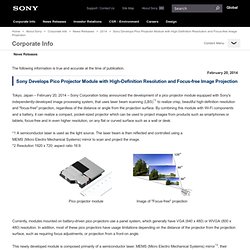
In addition, most of these pico projectors have usage limitations depending on the distance of the projector from the projection surface, such as requiring focus adjustments, or projection from a front-on angle. This newly developed module is composed primarily of a semiconductor laser, MEMS (Micro Electro Mechanical Systems) mirror*3, their respective drivers, and a video processor to control the video signal processing and image output. It adopts a LBS system that incorporates a semiconductor laser as the source of light, whereby the laser beam is reflected and controlled by a MEMS mirror to scan and project the image. Sony will continue the development of this module to achieve even more compact size and intense brightness, and aims to bring it to market for use in pico projectors and other devices with projector functionality. Microsoft Invents Advanced Optics for Future Xbox Eyewear. Microsoft's Patent Background A see-through display merges a display image and an external image, presenting both images in the same physical space.
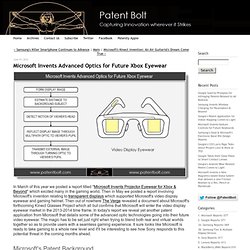
PS Vita - AR Suite Demonstration - PS Vita. La réalité virtuelle pour traiter l’anxiété, les phobies et le stress. Leaked Microsoft Document Reveals the Xbox 720, Kinect 2, and a Possible Google Glass Competitor. Du scan de tunnel comme dans Prometheus. FoldMe: Interacting with Double-sided Foldable Displays. Smartphones : la réalité augmentée au service de la traduction instantanée.
Communiquer, s’informer, travailler, payer, se laisser guider, jouer, voire répondre à des questions… les smartphones associés aux services en ligne dédiés sont aujourd’hui de véritables couteaux suisses numériques qui s’enrichissent régulièrement de nouvelles applications.

Notamment dans le domaine de la traduction. Dans cet esprit, l’entreprise japonaise Omron Software propose une solution pour traduire instantanément à l’écran un texte imprimé. Pour l’heure, le logiciel se limite à traduire quelques phrases courtes ou expressions anglaise, chinoise et coréenne en japonais. Une offre qui intéressera essentiellement les touristes japonais qui voyagent dans les pays frontaliers de leur patrie pour traduire cartes de restaurant ou panneaux de direction. Il devrait néanmoins être possible d’élargir le nombre de langues supportées. Vidéo : une petite amie en réalité augmentée.
Canon Mixed Augmented Reality Headset (video) « Haroldsax. At the 3D and Virtual Reality Expo in Tokyo last week Canon were showcasing their new Canon Mixed Reality Headset, which combines both real world environments and computer graphics, and will start shipping next month.
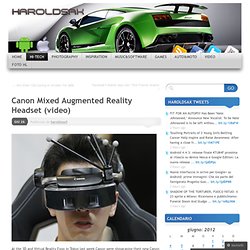
The Verge were able to put the new virtual augmented reality headset through its paces, and took apart a complex virtual airplane engine whilst wearing the headset, which you can see in the video after the jump. The Canon Mixed Reality Headset has been created to train people for difficult and dangerous applications, such as inside nuclear power stations, by combining reality and 3D computer graphics. The headset is equipped with two cameras, one placed over either eye and captures real-time video that is then sent to a wired connected computer. The Connected PC then processes the data to create what Canon promises to be a precise amalgamation of the real world and CGI. Pricing for the new Canon Mixed Reality Headset depends on the applications you require says Canon. Des trompe l'oeil incroyables en 3D sur un simple cahier de dessin. Mercredi 4 juillet Design - 4 juillet 2012 :: 09:19 :: Par Eric Trouvée chez This is colossal, cette galerie de dessins en perspective qui donnent une étonnante impression de 3D, réalisés par un artiste japonais, Nagai Hideyuki.
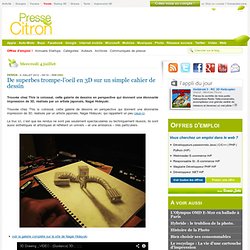
Trouvée chez This is colossal, cette galerie de dessins en perspective qui donnent une étonnante impression de 3D, réalisés par un artiste japonais, Nagai Hideyuki, qui rappellent un peu ceux-ci. Le truc ici, c’est que les rendus ne sont pas seulement spectaculaires ou techniquement réussis, ils sont aussi esthétiques et artistiques et reflètent un univers – et une ambiance – très particuliers. voir la galerie complète sur le site de Nagai Hideyuki (source) Olympus dévoile ses Google Glass-like. Depuis que Google a dévoilé sesGoogle Glass, les « smart glasses » sont à la mode.
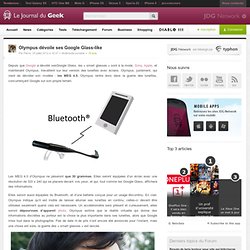
Sony, Apple, et maintenant Olympus, travaillent sur leur version des lunettes avec écrans. Olympus, justement, qui vient de dévoiler son modèle : les MEG 4.0. Olympus rentre donc dans la guerre des lunettes, concurrençant Google sur son propre terrain. Les MEG 4.0 d’Olympus ne pèseront que 30 grammes. MEG 4.0, les lunettes intelligentes de Olympus. Visiblement dans 3 ou 4 ans le gadget à la mode sera les lunettes intelligentes.
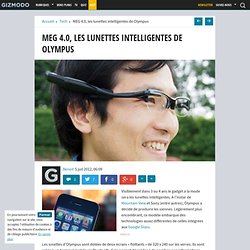
A l'instar de Mountain View et Sony (entre autres), Olympus a décidé de produire les siennes. Légèrement plus encombrant, ce modèle embarque des technologies assez différentes de celles intégrées aux Google Glass. Les lunettes d’Olympus sont dotées de deux écrans « flottants » de 320 x 240 sur les verres. Ils sont reliés à un terminal mobile via Bluetooth. This Gizmo Lets You Draw A UI On Paper, Then Turns It Into A Touch Screen. You know those huge multichannel mixers--the massive boards that audio engineers manage during concerts to control everything from sound to lights?

It’s the sort of highly specialized hardware that the average person would never come into contact with, because why would they? But what if you could just draw it? That’s the idea behind the SketchSynth, by Carnegie Mellon student Billy Keyes. It allows you to draw your own specialized piece of sound hardware--in this case, a MIDI board--on any random piece of paper.
“Ever since I was little, I’ve been fascinated by control panels,” Keyes explains on his blog. His approach is a compromise between boundless childhood imagination and human factors of practicality: He designed three distinct controls that anyone could draw. Researchers Modify Kinect Gaming Device to Scan in 3-D. Making a freehand 3-D scan of Tiffany Fox in Calit2's StarCAVE using a modified Kinect.
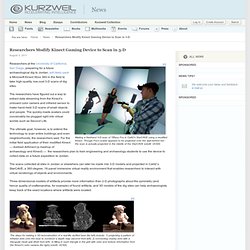
Though Fox's avatar appears to be projected onto the wall behind her, the scan is actually projected in the middle of the StarCAVE (credit: UCSD) Researchers at the University of California, San Diego, preparing for a future archaeological dig to Jordan, will likely pack a Microsoft Kinect Xbox 360 in the field to take high-quality, low-cost 3-D scans of dig sites. The researchers have figured out a way to extract data streaming from the Kinect’s onboard color camera and infrared sensor to make hand-held 3-D scans of small objects and people. The quickly-made avatars could conceivably be plugged right into virtual worlds such as Second Life.
The ultimate goal, however, is to extend the technology to scan entire buildings and even neighborhoods, the researchers said. The Kinect streams data at 40 megabytes per second. Another advantage of the Kinect is cost: It retails for $150. Changez votre décoration en moins d'une seconde. Contrairement à ce que l'on pourrait penser à la vue de ce petit salon, cette pièce est complètement blanche .
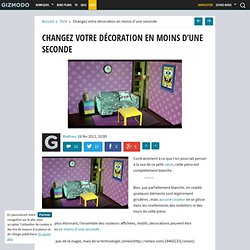
Panasonic's Third Eye Camera Concept: Terrible Haircut Required! Les élèves font appel à un professeur virtuel pour les aider dans leurs devoirs via un smartphone et un QRCODE. Microsoft présente le Beamatron, un concept de réalité augmentée. Microsoft propose régulièrement de nouveaux concepts par l’intermédiaire de son groupe de travail Microsoft Research. Microsoft envisage un casque de jeu avec lunettes 3D pour sa Xbox. Vuzix présente ses nouvelles lunettes à vue mélangée. Vuzix présente ses lunettes nouvelle génération. Augmented Projectors. In this project we investigate novel handheld projector systems for indoor spaces. These projection-based devices are “aware” of their environment in ways not demonstrated previously. They offer both spatial awareness, where the system infers location and orientation of the device in 3D space, and geometry awareness, where the system constructs the 3D structure of the world around it, which can encompass the user as well as other physical objects, such as furniture and walls.
This paper presents two novel handheld projector systems for indoor pervasive computing spaces. These projection-based devices are “aware” of their environment in ways not demonstrated previously. They offer both spatial awareness, where the system infers location and orientation of the device in 3D space, and geometry awareness, where the system constructs the 3D structure of the world around it, which can encompass the user as well as other physical objects, such as furniture and walls.
Projection-based MR. The 7th Sense. Google Translate Audio. (Cross-posted on the Mobile Blog and the Translate Blog) Mobile technology and the web have made it easier for people around the world to access information and communicate with each other. But there’s still a daunting obstacle: the language barrier. We’re trying to knock down that barrier so everyone can communicate and connect more easily.